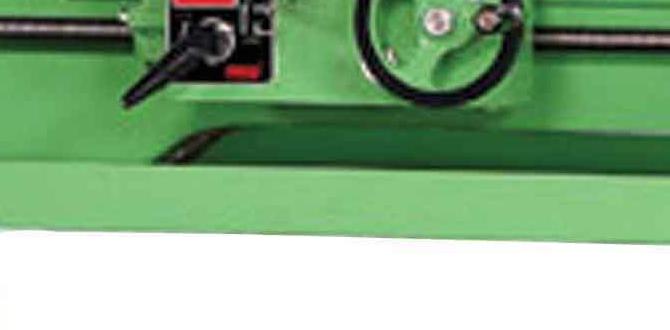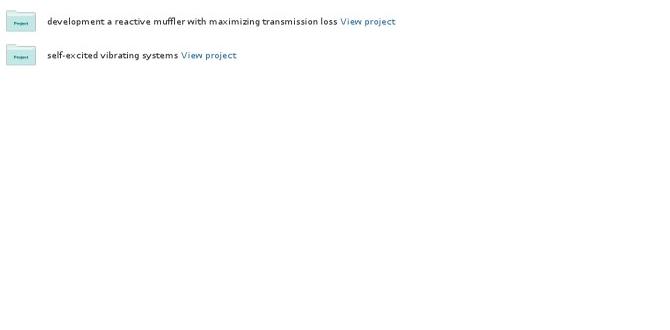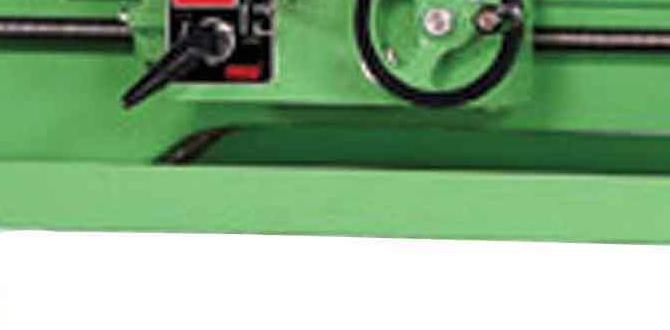Quick Summary:
Mastering grinding angles for lathe tools is crucial for clean cuts and tool longevity. This guide breaks down the essential angles—clearance, rake, and cutting—explaining how they affect performance and providing simple ways to achieve them for beginners. Achieve professional results with confidence.
Welcome to Lathe Hub! If you’ve ever struggled to get a clean cut on your lathe, or watched your tool corners crumble away too soon, you’re in the right place. The secret often lies in how you grind your cutting tools. It might seem a bit daunting at first, but understanding the basic angles makes a world of difference. We’ll break down these essential angles into simple terms. You’ll learn why they matter and how to achieve them with your grinder, giving you the power to make your lathe tools perform like new!
The Importance of Correct Grinding Angles for Your Lathe Tools
As a machinist, I’ve seen many beginners shy away from grinding their own lathe tools. Many think it’s a dark art, best left to the pros. But honestly, getting the angles right is one of the most fundamental and rewarding skills you can develop. When your lathe tool is ground correctly, it cuts smoothly, produces a better finish on your workpiece, and lasts much longer. This means less frustration for you and better results on your projects. Let’s make sure your tools cut, not rub!
Demystifying Lathe Tool Angles: A Beginner’s Blueprint
Think of your lathe tool like a chisel, but for metal or wood. To cut effectively, its edges need to be just right. This involves three main types of angles, each playing a vital role:
- Clearance Angles: These angles ensure the non-cutting surfaces of the tool don’t drag against the workpiece.
- Rake Angles: These angles help the cutting edge slice through the material efficiently and direct chips away.
- Cutting Edge Angle: This is the sharp point that actually contacts the material.
Getting these angles balanced leads to a tool that both cuts cleanly and remains durable. We’ll explore each one in detail.
1. Clearance Angles: Keeping the Tool off the Work
The clearance angle is probably the most critical for a beginner to understand first. Imagine trying to push a knife through a piece of paper, but the back of the knife blade is dragging on the paper too. It wouldn’t cut well, right? Clearance angles do the same job for your lathe tool.
There are two types of clearance angles:
Side Clearance Angle
This is the angle ground on the side of the tool, behind the cutting edge. It’s there to prevent the side of the tool from rubbing against the cylindrical surface of the workpiece as you make a cut. If the side clearance is too small, the tool will rub, creating friction, heat, and a poor finish. If it’s too large, the tool can become weak and more prone to chipping.
End Clearance Angle (or Front Clearance Angle)
This angle is on the small surface at the very tip of the tool, directly beneath the cutting edge. It helps ensure that only the cutting edge makes contact with the workpiece. Without enough end clearance, the tool might engage the workpiece too broadly, leading to chatter, glazing, and excessive heat. Too much end clearance can weaken the cutting edge.
Typical Clearance Angle Values
For most general-purpose turning and facing operations on a metal lathe, typical clearance angles are:
- Side Clearance: 5 to 15 degrees. Start with around 10 degrees for most materials. High-speed steel (HSS) tools often benefit from slightly more clearance than carbide inserts.
- End Clearance: 5 to 10 degrees. A good starting point is 5 degrees.
For woodworking lathes, especially with chisels, these angles can be slightly different and often larger to allow for easier movement and less binding in softer materials. A common range for wood carving chisels is 30-45 degrees for the combined bevel angle.
Safety first! When grinding, always wear safety glasses to protect your eyes from sparks and metal chips. Make sure your grinder has a sturdy tool rest set close to the grinding wheel to support your tool.
2. Rake Angles: Slicing and Directing Chips
Rake angles determine how efficiently your tool slices into the material and how the chips are formed and evacuated. They are usually ground on the top surface of the tool.
Back Rake Angle
This is the angle of the top surface of the tool relative to a horizontal plane. Imagine you’re looking at the end of the tool bit:
- Positive Back Rake: The top surface slopes downwards away from the cutting edge. This makes for a sharper, keener edge, which is excellent for slicing through materials like soft metals (aluminum, brass) and many woods. It reduces cutting forces and improves chip formation.
- Negative Back Rake: The top surface slopes upwards away from the cutting edge. This makes the cutting edge stronger and is used for harder materials or for heavy, interrupted cuts where toughness is more important than sharpness.
- Zero Back Rake: The top surface is flat and parallel to the workpiece. This is rarely used for general machining but might be found on specific tools.
General Rule of Thumb: For most everyday tasks on a metal lathe, a mild positive back rake (5-15 degrees) is very effective. Very soft metals or plastics often benefit from a steeper positive rake (up to 20 degrees). Harder steels might use zero or slight negative rake.
Side Rake Angle
This angle is ground on the small face that runs along the side of the cutting edge. It works in conjunction with the back rake to help curl and shear the chip away from the workpiece. Like back rake, it can be positive or negative, but positive side rake is far more common for turning tools on a metal lathe.
- Positive Side Rake: The top surface slopes downwards to the side away from the cutting edge. This helps guide the chip and reduces friction. Crucial for proper chip evacuation.
- Negative Side Rake: The top surface slopes upwards to the side away from the cutting edge. This is used for very hard materials or heavy cuts, but it’s less common for general-purpose turning.
Typical Side Rake Values: For general steel and cast iron turning, 10-15 degrees of positive side rake is a good starting point. For softer materials like aluminum, slightly more positive rake can be beneficial.
Tip: Many standard HSS lathe bits are pre-ground with recommended rake angles. Once you’ve used them, focus on maintaining those original angles when you resharpen.
3. The Cutting Edge Angle: The Heart of the Cut
This is the angle formed by the intersection of the top face (influenced by the rake angles) and the flank (influenced by the clearance angles) at the very point where the tool meets the workpiece. It determines the sharpness and strength of the cutting edge.
A smaller angle creates a sharper edge, which is better for slicing and for softer materials. A larger angle creates a stronger, more robust edge, which is better for harder or tougher materials and for heavy cuts.
Typical Cutting Edge Angle Values
Here’s a general guide for the cutting edge angle (also sometimes referred to as the primary cutting edge angle or point angle):
| Material Being Cut | Typical Cutting Edge Angle | Notes |
|---|---|---|
| Soft Woods | 25-35 degrees | Sharp edge for easy slicing. |
| Hard Woods | 30-45 degrees | Slightly more robust edge. |
| Mild Steels & Aluminum | 55-65 degrees | Good balance of cutting ability and edge strength. |
| Stainless Steels & Other Tough Alloys | 65-75 degrees | Stronger edge needed to resist chipping and wear. |
| Cast Iron | 60-70 degrees | Can be abrasive; edge needs some strength. |
Important Note: These are the angles at the very tip. The angle you grind on your grinding wheel will be a combination of the clearance and rake angles to achieve this effective cutting edge angle.
Putting It All Together: Common Lathe Tool Grinding Scenarios
Let’s look at a few common tools and what angles you might aim for.
Roughing Tool (for Metal Lathes)
This tool is designed for removing material quickly. It needs to be strong and durable.
- Clearance Angles: 8-12 degrees (side), 5-8 degrees (end).
- Rake Angles: 0-5 degrees positive back rake, 10-15 degrees positive side rake.
- Cutting Edge Angle: Around 60-70 degrees. The stronger, blunter edge handles heavy loads better.
Finishing Tool (for Metal Lathes)
This tool is for making smooth surfaces. It needs a sharp, clean edge.
- Clearance Angles: 10-15 degrees (side), 5-10 degrees (end). More clearance helps prevent rubbing.
- Rake Angles: 10-15 degrees positive back rake, 10-15 degrees positive side rake. A more acute angle helps slicing.
- Cutting Edge Angle: Around 55-65 degrees. A sharper edge leads to a better finish.
Scrapers (for Wood Lathes)
Wood scrapers work differently. They are meant to shear wood fibers.
- Angle: Typically, the bevel is ground at a relatively steep angle (around 45 degrees) and then a tiny burr is formed on the edge by “burnishing” with a steel rod. This burr is the actual cutting edge. Clearance angles are less critical here compared to metal tools.
How to Grind Your Lathe Tools: A Step-by-Step Approach
Now, let’s get practical. You’ll need a grinding setup. A bench grinder with a suitable wheel (like a white or brown aluminum oxide wheel for steel) is common. For woodworking tools, a grinder with a slower speed and perhaps a Tormek or similar waterstone system is often preferred to avoid burning the wood.
Always ensure your grinder is in good condition, the wheel is clean and dressed, and your tool rest is securely in place and set correctly.
- Safety First: Wear your safety glasses and hearing protection. Ensure your grinder has a good spark arrestor.
- Set Up Your Tool Rest: Adjust the tool rest so it’s very close to the grinding wheel (about 1/8 inch or 3mm clearance) and slightly below the center line of the wheel. For grinding angles, you’ll often want the rest set at the approximate angle you’re trying to achieve, or use a grinding jig.
- Pre-Determine Your Angles: Have your target angles in mind. For beginners, start with widely accepted angles for standard HSS bits.
- Grind the Clearance Angles:
- For side and end clearance, you’ll typically hold the tool bit against the tool rest and rock it slightly to create the angled surface.
- Practice on scrap pieces of tool steel if you have them. The goal is a smooth, consistent surface.
- For metal tools, aim to grind the clearance angles first before tackling the rake angles.
- Grind the Rake Angles:
- Once clearance is established, you’ll grind the top surface (back rake) and the side face (side rake) to create the cutting profile.
- This is where precision matters. You might use an angle gauge or even a protractor to check your progress.
- For a positive back rake, you’ll grind the top surface so it slopes away from the cutting edge. For side rake, you’ll grind the side face to slope away.
- Form the Cutting Edge: As you grind the rake and clearance, the sharp cutting edge will form. You want a continuous, crisp edge.
- Deburring and Honing:
- After grinding, there will be a tiny burr or “wire edge” left on the cutting edge. You need to remove this. A few light passes on a fine grit stone or even a hard wood block can do this.
- For best results, especially on finishing tools, hone the cutting edge on fine sharpening stones (like Japanese water stones or diamond plates) to achieve razor sharpness. This usually involves holding the tool at an even shallower angle than the cutting edge angle to refine the keenness.
- Check Your Work: Visually inspect the tool. Does it look symmetrical? Is the edge sharp? Try a light cut on a piece of scrap material. Does it cut Freely?
Using Grinding Jigs: For consistent results, especially when learning, consider using grinding jigs. These help you hold the tool at a precise angle against the grinding wheel, making it much easier to achieve accurate clearance and rake angles. Many multi-purpose jigs are available.
Understanding Carbide Insert Tooling vs. HSS
A significant number of beginners today start with machines that use carbide inserts. These are small, interchangeable pieces of extremely hard material that do the cutting. You don’t grind carbide inserts themselves (they are manufactured to precise angles). Instead, you typically use them with tool holders that have specific geometry, and you swap them out when they wear out.
However, many hobbyists and professionals still use High-Speed Steel (HSS) tool bits. These are the ones you grind yourself. The knowledge of grinding angles is vital if you’re working with HSS, which remains popular for its affordability and ease of sharpening for specific tasks.
If you are using carbide, your focus shifts to selecting the correct insert grade for your material and using appropriate tool holders that might offer slight effective rake angles. For more on carbide inserts, you can refer to resources from manufacturers like Sandvik Coromant, a leading global supplier of cutting tools.
Troubleshooting Common Grinding Issues
Even with practice, you might run into some problems:
- Tool Chattering: Often caused by insufficient clearance angles, a weak cutting edge angle, or a dull tool. Re-grind with a bit more clearance and ensure the cutting edge you’ve ground is crisp and not rounded.
- Poor Surface Finish: This can be due to insufficient rake angles (leading to rubbing), a damaged cutting edge, or not honing the tool sharp enough. Make sure your rake angles are appropriate for the material and consider honing the tool after grinding.
- Rapid Tool Wear: This might happen if your clearance angles are too small (causing rubbing and heat) or if you’re using too steep a cutting edge angle for a soft material, leading to chipping. It could also be the wrong tool steel or insert grade for the material.
- Burning the Tool: Grinding too long in one spot can overheat and “temper back” the HSS, ruining its hardness. Use light passes, dip the tool in water frequently to cool it, and don’t force it.
FAQ: Your Lathe Tool Grinding Questions Answered
Here are some common questions beginners have about grinding lathe tools:
Q1: What are the most important angles to get right first?
A1: For metal lathe tools, focus on the side and end clearance angles first. Without proper clearance, the tool will rub the workpiece, causing poor finish and excess heat, no matter how sharp the cutting edge is.
Q2: Should I use a grinder jig?
A2: Yes, especially when starting. Grinding jigs help you maintain consistent angles reliably, which is crucial for good tool performance. They take the guesswork out of holding the tool.
Q3: How often do I need to regrind my tools?
A3: It depends on the material being cut, the depth of cut, and how long you’re cutting for. For metalworking, you might regrind after each significant job or when you notice a degradation in cut quality. For woodworking, it might be less frequent, but when the tool feels like it’s “rubbing” instead of “slicing,” it’s time.
Q4: Can I grind any type of steel to make lathe tools?
A4: For metalworking, it’s best to use High-Speed Steel (HSS) or tool steel. These are designed to retain hardness at high temperatures generated during cutting. Regular mild steel won’t hold an edge and



